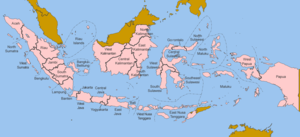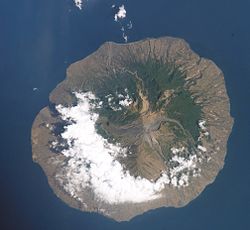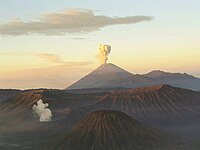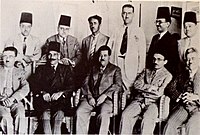Indonesia
| Republic of Indonesia | |
|---|---|
| Republik Indonesia | |
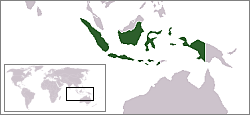
| |
 
| |
| Motto | Bhinneka Tunggal Ika (Old Javanese/Kawi: Unity in Diversity) National ideology: Pancasila |
| National anthem | Indonesia Raya |
| Capital (and largest city) | Jakarta |
| Official language | Indonesian |
| Government type | Republic |
| President | Susilo Bambang Yudhoyono |
| Vice President | Jusuf Kalla |
| Area | 1,904,569 km² 735,355 mi² (16th) (4.85% % water) |
| Population | 222,781,000 (4th) (2005 estimate) 206,264,595 (2000 census) |
| Population density | 117/km² (84th) 303 mi² |
| GDP (PPP) | Total:$977.4 billion (15th) Per capita:$4,458[1] (110th) (2005 estimate) |
| HDI | 0.697 (medium) (110th) (2003) |
| Currency | Rupiah (IDR) |
| Time zone | various (UTC+7 to +9) Summer:not observed (UTC+7 to +9) |
| Country codes | Internet TLD : .id Calling code : +62 |
Indonesia, officially the Republic of Indonesia (Indonesian: Republik Indonesia), is a nation of islands consisting of 18,110 islands in the South East Asian Archipelago. The capital is Jakarta, formerly known as Batavia. Indonesia (from Greek: indus = India nesos = islands) is the world's largest archipelagic nation, and it is bordered by the nations of Papua New Guinea, East Timor, and Malaysia. With a population of over 200 million, it is the world's fourth most populous country and most populous Muslim-majority nation.
The Indonesian archipelago, specifically Java, was inhabited by Homo erectus -- the Java Man -- about 500,000 years ago, while the island of Flores was home to what, as of 2006, may be a newly discovered species of hominid, Homo floresiensis.
The region was an important trade route to China, thriving in trade of spices. Regional Hindu kingdoms expanded religious and cultural influences of Hinduism as well as Buddhism, and in the Middle Ages, the islands came under the influence of Islam. The region was colonized by the Netherlands as the Dutch East Indies. The people across many islands rebelled in the early 20th century against Dutch control. After a brief occupation by Imperial Japan during World War II, nationalists declared independence in 1945, and a united and independent Indonesia was recognized in 1949. It was also recognized by the United Nations in 1950.
Indonesia is a unitary state, and for most of its post-independence history, was first governed by Sukarno, leader of the national independence struggle, and then under controversial and authoritarian Suharto. Democracy was restored following the revolution of 1998. Although the national language is Indonesian (called Bahasa Indonesia in Indonesian) and the population is overwhelmingly Muslim, there are several hundred diverse linguistic and ethnic groups across the country, as well as other religious communities. Although Indonesia's economy is progressive and regionally important, the problems of widespread corruption, poverty, illiteracy, political instability and regional separatism remain major issues hindering national development.
History
Early History and the Spice Trade
The area now comprising the archipelago of Indonesia, specifically Java, was inhabited by Homo erectus approximately 500,000 years ago, while the island of Flores was home to a newly discovered species of hominid, Homo floresiensis until approximately 10,000 years ago.[2] The date of the earliest arrival of Homo Sapiens into the area was between 40,000 and 100,000 years ago.[3] The earliest historical mention of the area was of the Jawa Dwipa Hindu kingdom in Java and Sumatra around 200 BC by Indian scholars, and various archeological sites show the influence of the Hindu religion in the area from the first century AD to the fifth century AD.
Under the influences of Hinduism and Buddhism, several kingdoms formed on the islands of Sumatra and Java from the 7th to 14th century. The arrival of Arabs trading in spices later brought Islam, which became the dominant religion in many parts of the archipelago after the collapse of Hindu and Buddhist kingdoms.[3] When the Portuguese came in early 16th century, they found a multitude of small states vulnerable to the Portuguese, and later other Europeans, wanting to dominate the spice trade.
In the 17th century, the Dutch became the most powerful of the European powers in the archipielago, preventing the Spanish from any attempt to settle down from the neighbouring Philippines and ousting the Portuguese from their settlements other that their colony of Portuguese Timor on the island of Timor which remained Portuguese until the 20th century. The British occupied Bencoolen (south of Sumatra) from 1685 to 1824 and built "Fort Marlborough".
The Dutch
Dutch influence started with trading by the Dutch East India Company (VOC), a chartered private enterprise constituting a state in all but name, complete with its own fleet and army, which gradually expanded its influence and grip on political matters.[4] Like the British, the Dutch mainly relied on indirect rule, using traditional native elites as vassals, while imposing their will and extracting major income under supervision by their colonial officials. After VOC was dissolved in 1799 by the Batavian Republic (Napoleon's Dutch satellite state) and the political instability from the Napoleonic Wars including partial British occupation (1811-1816).
Under British occupation, Thomas Stamford Raffles was appointed as the lieutenant governor of Java (1811-1816).[5] Bogor Botanical Garden was conceived based on his inspiration. He also wrote "History of Java" book.[6] Based on Anglo-Dutch Treaty of 1824 Bencoolen (South of Sumatra) was exchanged for Malacca.
Based on Treaty of Paris (1815), The East Indies were awarded to the United Kingdom of the Netherlands. Since then, the East Indies were officially ruled as the colonies of the Dutch crown.
There were 3 major rebellions against Dutch occupation:[7]
- Java War (1825-1830). The rebels were led by Prince Diponegoro from the kingdom of Mataram, central Java.
- Padri War (1821-1837) in West Sumatra. The rebels were led by Tuanku Imam Bonjol.
- Aceh War (1873-1903) in Aceh.
Under the 19th-century Cultivation System (Cultuurstelsel), large plantations and forced cultivation were established on Java, finally creating the profit for the Netherlands that the VOC had been unable to produce.[8] In a more liberal period of colonial rule after 1870, the Cultivation System was abolished, and after 1901 the Dutch introduced the Ethical Policy, which included limited political reform and increased investment in the colony.
Japanese Occupation, Independence & Sukarno
During World War II, with the Netherlands under German occupation, Japan began a five-prong campaign in December 1941 towards Java and the vital fuel supplies of the Dutch East Indies.[9] Though Japan captured Java by March 1942, it initially could not find any national leader willing to collaborate with the Japanese government against the Dutch. Eventually the Japanese commander ordered Sukarno's release from his prison island, and in July 1942, Sukarno arrived in Jakarta. Sukarno and his colleagues weren't collaborating with the Japanese occupiers.[10] In 1945, with the war drawing to a close, Sukarno was made aware of an opportunity to declare independence. In response to lobbying, Japan agreed to allow Sukarno to establish a committee to plan for independence.[11] However, Sukarno and Mohammad Hatta declared independence unilaterally on August 17 soon after the Japanese lost the war. Following the defeat of Japan in the World War, the Netherlands' Army, at first backed by the British, attempted to reoccupy their former East Indies colonies.[12] Indonesia's war for independence lasted from 1945 until December 27, 1949 when, under heavy international pressure, especially from the United States, which threatened to cut off Marshall Plan funds, the Netherlands acknowledged the independence of Indonesia as a Federation of autonomous states.[13] This federation soon became a republic with Sukarno as president and Hatta as vice president. See Indonesian National Revolution. It was not until August 17 2005 that the Dutch government recognized 1945 as the country's year of independence and expressed regrets over the Indonesian deaths caused by the Netherlands' Army.[14]
The New Order

The 1950s and 1960s saw Sukarno's government aligned first with the emerging non-aligned movement and later with the socialist bloc. The 1960s saw Indonesia in a military confrontation against neighbouring Malaysia, and increasing frustration over domestic economic difficulties.[15] Army general Suharto became president in 1967 on the pretext of securing the country against an alleged communist coup attempt against a weakening Sukarno, whose tilt leftward had alarmed both the military and Western powers. In the aftermath of Suharto's rise, hundreds of thousands of people were killed or imprisoned by the military and religious groups in a backlash against alleged communist supporters.[16] Suharto's administration is commonly called the New Order era.[17] Suharto invited major foreign investment, which produced substantial, if uneven, economic growth. However, Suharto enriched himself and his family through widespread corruption and was forced to step down amid massive popular demonstrations and a faltering economy by the Indonesian Revolution of 1998.[18] From 1998 to 2005, the country had four presidents: Bacharuddin Jusuf (BJ) Habibie (1998 to 1999), Abdurrahman Wahid (1999 to 2001), Megawati Sukarnoputri (2001 to 2004) and Susilo Bambang Yudhoyono (2004 to Current).[19] On May 21, 1998, President Suharto announced his resignation and ask Indonesian Vice President DR BJ Habibie to become the new Indonesian President.
Reformasi
President BJ Habibie promised a multiparty, free, democratic election in 1999.[20] He encouraged freedom of the press.[21] His presidency was plagued by various bloody conflicts, both long-running ones in Aceh and West Papua and new ones in Maluku, Poso (Sulawesi), and Kalimantan. There was a major financial scandal (Bank Bali case) related to his friends and the staff of his political party.[22] On 1999, President BJ Habibie agreed to hold a referendum in East Timor.[23] The result of the referendum was an overwhelming vote for independence from Indonesia. After the announcement of the result, there was a bloody riot in East Timor by the angry pro-Indonesia militia. The militia burned down houses, shops, schools, churches, government buildings and hundreds of people were killed.[24] The UN sent a peace keeping force to East Timor (UNTAET). The UN Human Rights Commission alleged that several Indonesian government staff and military officers were responsible for the riot. The Indonesian Human Rights Court freed all but one suspect. The only suspect punished for the human rights violation during the riot was Enrico Gutierrez, a former leader of the pro-Indonesia militia.[25]
There was a general election for members of Indonesian parliament MPR (Majelis Permusyawaratan Rakyator People's Consultative Assembly) and Dewan Perwakilan Rakyat (DPR) or People Representative Council in 1999 and 2004. In the same 2004 election, people also voted for members of a new parliament body called Dewan Perwakilan Daerah (DPD) or Provinces Representative Council. In 1999, the parliament (MPR) rejected President Habibie's accountability speech because of the result of the East Timor referendum.[26] President Habibie decided to resign and refused to run for a second term.
The parliament chose KH Abdulrahman Wahid (aka Gus Dur) as the new Indonesian President from 1999 to 2004. KH Abdulrahman Wahid was the leader of the most powerful Indonesian Islamic organization, Nadathul Ulama (NU). Unfortunately, he was plagued by serious health problems after a stroke (before he became the Indonesian President).[27] The parliament also chose Megawati Sukarnoputri as the new Indonesian Vice President. In 2001 the same parliament voted "No confidence" after a corruption scandal (BULOG fund) and a political crisis, forcing President Wahid to resign.[28]
Megawati Sukarnoputri succeeded the former President Wahid as the new Indonesian president from 2001 to 2004. She is the daughter of the first Indonesian President, Ir. Sukarno, and the leader of PDI-P, which was the winner of 1999 election.[29] Indonesia's first direct presidential election was held in 2004, in which Susilo Bambang Yudhoyono defeated Megawati.[29]
Government and politics
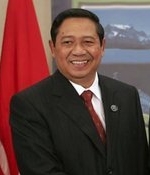
Template:Morepolitics Indonesia is a republic with a presidential system, and a unitary state with power concentrated with the national government. The President of Indonesia is directly-elected for five-year terms, and is the head of state, commander-in-chief of Indonesian armed forces and responsible for domestic governance and policy-making and foreign affairs. The president appoints a council of ministers, who do not have to be elected members of the legislature.
The highest legislative body is the Majelis Permusyawaratan Rakyat or 'People's Consultative Assembly', consisting of the Dewan Perwakilan Rakyat (DPR, Deputy Speaker: Agung Laksono) or People's Representative Council, elected for a five-year term, and the Dewan Perwakilan Daerah or Regional Representatives Council. Following elections in 2004, the MPR became a bicameral parliament, with the creation of the DPD as its second chamber in an effort to increase regional representation.[30]
During the regime of president Suharto, Indonesia built strong relations with the United States[31] and had difficult relations with the People's Republic of China owing to Indonesia's anti-communist policies and domestic tensions with the Chinese community[32][33].
It received international condemnation for its annexation of East Timor in 1978.[34] Indonesia is a founding member of the Association of South East Asian Nations,[35] and thereby a member of both ASEAN+3 and the East Asia Summit. Since the 1980s, Indonesia has worked to develop close political and economic ties between South East Asian nations, and is also influential in the Organization of Islamic Conference. Indonesia was heavily criticized between 1998 and 1999 for allegedly suppressing human rights in East Timor, and for supporting violence against the East Timorese following the latter's secession and independence in 1999.[36]
Following the loss of East Timor in 1999, the Indonesian Government has found considerable, but not complete success in managing separatist issues in Aceh and Papua. Under the administration of President Yudhoyono, a cease fire agreement was reached with the Free Aceh Movement (Gerakan Aceh Merdeka or GAM) in 2006, and in Papua there has been a significant, albeit imperfect, implementation of regional autonomy laws, and a reported lessening of violence and human rights abuses [37] In 2006, sensitivities over the Papua issue resulted in the Indonesian Government recalling its ambassador to Australia following that country's government granting protection visas to 42 Papuan asylum seekers.[38]
After the 2002 Bali bombing, terrorist activities have become increasing significant in Indonesia. The bombing, in which 202 people, including 164 international tourists died, destroyed two nightclubs in Kuta, Bali.[39] By looking at the number of international tourist deaths, the terrorist activity has been taken very seriously not only by the Indonesian government, but also international world, including Australia, The United States and The United Kingdom.[40] Since 2001, the government of Indonesia has co-operated with the U.S. in cracking down on Islamic fundamentalism and terrorist groups.[41] Over the next four years there were several other terrorist attacks including the 2003 Marriott Hotel bombing, 2004 Jakarta embassy bombing and 2005 Bali bombing. As a result, a number of countries have issued travel warnings for international tourists and workers.[42]
Administrative divisions
Indonesia currently has 33 provinces, of which three have special status and one is a special capital region. The provinces are subdivided into regencies and cities, which are further subdivided into sub-districts.
The provinces are: Nanggroe Aceh Darussalam*, Bali, Bangka-Belitung, Banten, Bengkulu, Gorontalo, West Irian Jaya (Irian Jaya Barat), Jakarta*, Jambi, West Java (Jawa Barat), Central Java (Jawa Tengah), East Java (Jawa Timur), West Kalimantan (Kalimantan Barat), South Kalimantan (Kalimantan Selatan), East Kalimantan (Kalimantan Timur), Central Kalimantan (Kalimantan Tengah), Riau Islands (Kepulauan Riau), Lampung, Maluku, North Maluku (Maluku Utara), West Nusa Tenggara (Nusa Tenggara Barat), East Nusa Tenggara (Nusa Tenggara Timur), Papua*, Riau, West Sulawesi (Sulawesi Barat), South Sulawesi (Sulawesi Selatan), Central Sulawesi (Sulawesi Tengah), South East Sulawesi (Sulawesi Tenggara), North Sulawesi (Sulawesi Utara), West Sumatra (Sumatera Barat), South Sumatra (Sumatera Selatan), North Sumatra (Sumatera Utara), Yogyakarta*.
(*) The provinces which have special status.
The special territories have more autonomy from the central government than other provinces, and so have unique legislative privileges: the Acehnese government has the right to create an independent legal system, and instituted a form of sharia (Islamic Law) in 2003; Yogyakarta remains a sultanate whose sultan (currently the widely popular Sri Sultan Hamengkubuwono X) is the territory's de facto governor for life. Papua (formerly called Irian Jaya) has had special status since 2001. The special capital region is Jakarta. Though Jakarta is a single city, it is administered much as any other Indonesian province. For example, Jakarta has a governor (instead of a mayor), and is divided into several sub-regions with their own administrative systems.
East Timor was occupied by Indonesia from 1975 following a military invasion, until Indonesia relinquished its claims in 1999 after years of bitter fighting against East Timor guerrillas and abuses by Indonesian military forces against the East Timorese civilians. Following a period of transitional administration by the UN, it became an independent state in 2002.
Geography
At 1,919,440 km² (741,050 mi²), [43] Indonesia is the world's 16th-largest country in area and its population density of 120.5 people per square kilometer ranks 98th in the world.
Indonesia's 18,108 islands, of which about 6,000 are inhabited,[44] are scattered around the equator, giving the country a tropical climate. The most populated islands are Java (one of the most densely populated regions on Earth, where about half of the population lives), Sumatra, Borneo (shared with Malaysia and Brunei), New Guinea (shared with Papua New Guinea) and Sulawesi, also known as Celebes. Indonesia borders Malaysia on the island of Borneo (Indonesian: Kalimantan), Papua New Guinea on the island of New Guinea and East Timor on the island of Timor. In addition to the capital city of Jakarta, principal cities of high population include Surabaya, Bandung, Medan, Palembang, and Semarang.
Its location on the edges of tectonic plates, specifically the Pacific, Eurasian, and Australian, means Indonesia is frequently hit by earthquakes and the resulting tsunamis. Indonesia has at least 66 volacanoes, [45] the most famous being the now-vanished Krakatau (Krakatoa) which was located between Sumatra and Java. Flora and fauna differ markedly between Kalimantan, Bali, and western islands on the one hand and Sulawesi (Celebes), Lombok, and islands further east on the other. This ecological boundary has been called the Wallace line after its discoverer. The line is often given as the boundary between Asia and Australasia, as such making Indonesia a bicontinental country. 45% of Indonesia is covered by forests.[46]
Recent Natural Disasters
A massive earthquake and tsunami on 26 December 2004 devastated parts of northern Sumatra, particularly Aceh. On March 2005, a powerful earthquake destroyed most buildings on Nias Island, west of Sumatra. Hundreds of people were killed. Partly as a result of the need for cooperation and peace during the recovery from the tsunami in Aceh, peace talks between the Indonesian government and Gerakan Aceh Merdeka (GAM, the Free Aceh Movement) were restarted and have borne fruit in a peace agreement. Under the agreement, GAM is in the process of being disarmed by international observers and Indonesian troops are being completely withdrawn from the region. GAM members are being permitted to run for office in the region, in a break with the Constitutional requirement that all parties that run for elections must have nationwide support. On the morning of Saturday, May 27, 2006, the city of Yogyakarta was struck by a severe earthquake. More than 6,000 people are currently estimated to have died.[47]
See also: Map of Asia
Economy
Major agricultural products include palm oil, rice, tea, coffee, spices and rubber. Some big industries in Indonesia are petroleum and natural gas, textiles, apparel and mining. Bank Indonesia, the country's central bank was established in 1974 and received its independent central bank status in 1999[48]. In 2005, the industrial production growth rate was 4.8%, made Indonesia on the 73th place on the world rank. Indonesia's major trading partners are Japan, the United States, Singapore, Malaysia and Australia.
The country has extensive natural resources outside Java, including crude oil, natural gas, tin, copper and gold. Indonesia is the world’s largest LNG producer, exporting about 20% of the world’s total volume in 2002.[49] Apparently, in 2005, the income from exports was larger than the import's expenditure with $83.64 billion and $62.02 billion respectively. Indonesia's imports commodities include machinery and equipment, chemicals, fuels, foodstuffs.[50]
Despite being the only East Asian member of OPEC, Indonesia's fuel production has declined significantly over the years, owing to aging oil fields and lack of investment in new equipment. As a result, despite being an exporter of crude oil, Indonesia is now a net importer of oil and had previously subsidized fuel prices to keep prices low, costing US$ 7 billion in 2004.[51] The current president has mandated a significant reduction of government subsidy of fuel prices in several stages.[52] In order to alleviate economic hardships, the government has offered one-time subsidies to qualified citizens. The government has stated to reduce subsidies, aiming to reduce the budget deficit to 1% of gross domestic product (GDP) this year, down from around 1.7% last year. The real Gross Domestic Product (GDP) of Indonesia is projected to reach 5.2% in the second half year of 2006.[53]
Since the late 1990s, Indonesia's economy suffered a drastic downturn followed by an at times patchy and slow recovery. This was due not only to the financial crisis that struck much of east Asia at the time, but also, due to corruption at all levels and a perceived slow pace of economic reform.[54]
Indonesia has received many aids in economic sector, which are varies in bilateral, multilateral and non-governmental organization (NGO). In addition to this, although Indonesia finished its IMF program in December 2003, the country still receives bilateral aid through the Consultative Group on Indonesia (CGI) which reached $2.8 billion for 2004 and 2005. Another aid was intended for the post-Tsunami reconstruction in Aceh through the NGO and reached $5 billion. The total of aid for Indonesia is $43 billion.[50]
- See also: Education in Indonesia
Demographics
Indonesia's population statistics are difficult to estimate. In the 2000 national census, an initial population estimate of 203 million was recorded, where most of the population of Aceh was estimated from previous counts as the conflict meant that a survey was not possible, as were hard-to-reach regions of Papua, although later the Indonesian government later revised the estimate up to 206 million.[55] The country's Central Statistics Bureau and Statistics Indonesia quote 222 million as the population for 2006,[56] while the CIA Factbook estimates are over 245 million[50].
It should be noted that CIA Factbook quotes a growth rate far higher at 1.45% versus less than 1% for BPS-Statistics Indonesia. Some parts of Indonesia are some of the most densely populated areas in the world: for example, Java is the most populous island in the world.[57]
Ethnic groups
Indonesia's population can be roughly divided into two groups. The west of the country is mostly occupied by Malay people, while the east is more Pacific and people on the island of New Guinea are Papuan, with roots in the islands of Melanesia. There are many more subdivisions, since Indonesia spans an area the size of Europe or the USA and consists of many islands that to a large degree had separate developments. Many Indonesians identify with a more specific ethnic group that is often linked to language and regional origins; examples of these are Javanese, Sundanese, or Batak. There are also quite different groups within many islands, such as Borneo, with its Dayak and Punan, who have different lifestyles and skintones. The total number of ethnic in Indonesia is 300 and the total number of different dialects is 742.[58][59] Small but significant populations of ethnic Chinese, Indians and Arabs are concentrated mostly in urban areas.
Indonesia is a diverse country not without its ethnic tensions, particularly between Indonesians of Chinese ethnicity and the Pribumi peoples, who are considered natives of Indonesia,[60] "Non-Pribumi" people are not always considered entirely Indonesian.[61] The riots in Jakarta in 1997 and 1998 highlight this recurring tension. Ethnic relations are strained mostly due to a perception that the Chinese community is too rich relative to the Pribumis.[62] The Chinese community, representing 0.9% of the population, is on average wealthier than the Pribumis,Template:Fact and positions of power and influence in the business sphere are indeed held by relatively few very wealthy ethnic Chinese Indonesians.Template:Fact However, some of the resentment may be against the shopkeepers and more or less small-time creditors who constitute much of the Chinese Indonesian community.Template:Fact Chinese people occupied these roles under Dutch rule, and were used as middlemen and treated as second-class citizens, while Pribumi peasants and laborers were treated as third-class citizens.Template:Fact Chinese-owned shops and the families living and working in storefront dwellings were targets of much of the wrath of the rioters. The Indonesian government is attempting to remedy problems which helped trigger the riots,[63] but due to widespread corruption and discontent experienced by poorer Indonesians, ethnic harmony is slow in coming. The corruption, collusion, and nepotism ('KKN' is the Indonesian abbreviation) which characterized Suharto presidency, built up a public resentment that led to the eventual downfall of the Orde Baru (New Order) regime but also clearly exacerbated ethnic tensions in Indonesia.[64]
The Government sponsored transmigration since independence through to the late 1990s, has in part contributed to spread of Muslim peoples from highly populated Java in the west towards eastern Indonesia. Another type of ethnic conflict that occurs with some frequency and lethality in certain areas of Indonesia is between people with deep roots in those areas and Javanese and Madurese people whose internal migration (transmigrasi) to those areas was facilitated by the central government.[63] This type of conflict often takes on religious overtones, too, as Muslim Javanese and Madurese find themselves in areas which were predominantly Christian or animist. A particularly horrific example of this type of ethnic violence occurred in West Kalimantan, where some members of the local Dayak community massacred hundreds of Madurese, and the survivors ran for their lives.[65] Other fatal conflicts, which were at least partly sparked by differences between internal migrants and members of the pre-existing local population, include Ambon,[66] Central Sulawesi,[67] and parts of Papua and West Irian Jaya (formerly known as Irian Jaya).
Languages
The official national language, Indonesian (called Bahasa Indonesia in Indonesian), is universally taught in schools and is spoken by nearly every Indonesian. It is arguably the greatest national unifying tool for a country made up of hundreds of different ethnic and linguistic groups. It is the language of business, politics, national media, education and academia. Yet, in isolated areas even on the major islands it is not uncommon to find villagers who are not familiar with Indonesian. It was originally a lingua franca for most of the region, including present-day Malaysia (and is thus closely related to Malay), accepted by the Dutch as the de facto language for the colony, and declared the official language after independence.
Most Indonesians speak at least one of the several hundreds of local languages (bahasa daerah) as their first tongue, with Javanese the most widely-spoken being the language of the country's largest ethnic group.[50]
Although Islam is the dominant religion, Arabic is not spoken in Indonesia, except for some religious functions, although even then, Indonesian is mostly used.
Religion
Islam is Indonesia's main religion, with almost 86% of Indonesians declared Muslim according to the 2000 census,[50] making Indonesia the most populous Muslim-majority nation in the world. The remaining population is 11% Christian (of which roughly two-thirds are Protestant with the remainder mainly Catholic, and a large minority Charismatic), 2% Hindu and 1% Buddhist. Before the arrival of the Abrahamic faiths of Christianity and Islam in the Malay Archipelago, the popular beliefs in region had been thoroughly influenced by Indic religious philosophy through Hinduism and Buddhism. Although Islam was once mainly practised in Java and parts of Sumatra, the transmigration program has increased the number of Muslims living in Bali, Borneo, the Celebes, the Moluccas, and Papua. After independence, syncretism and intermarriage has decreased somewhat and religious divides sharpened, leading to communal violence in many eastern islands and in Java. Although only about 3% of Indonesians are officially Hindu, Indonesian beliefs are too complex to classify as belonging to a single world religion. In Java in particular, a substantial number of Muslims follow a non-orthodox, Hindu-influenced form of Islam known as Abangan,[68]while across the archipelago the Hindu legacy, along with the older mystic traditions, influences popular beliefs. In areas of North Sumatra and Borneo, mystic traditions sometimes blend with Christianity to form mixed belief systems. In recent decades, Hinduism has shown a resurgence in Muslim strongholds including the center, Java. The phenomenon of "reconversion" is thought to be especially accelerated, and has roots in not just religious sentiment, but Indonesian nationalism.
Culture

Indonesia has around 300 ethnic groups each with cultural differences which have shifted over the centuries. One example is the Borobudur temple, which is a mix of Hinduism and Javanese culture, as it was built by a Javanese dynasty, the Sailendra. Indonesia has also imported cultural aspects from Arabic, Chinese, Malay and even European sources.
Art forms in Indonesia have been influenced by several cultures. The famous Javanese and Balinese dances, for example, contain aspects of Hindu culture and mythology. Also well-known are the Javanese and Balinese wayang kulit shadow theatre shows, displaying several mythological events. Several islands are famous for their batik, ikat and songket cloth.
Pencak Silat is a unique martial art originating from the archipelago.
Indonesian music varies within cities and groups as people who live in the countryside would listen to a different kind of music than people in the city. Although rock was introduced in Indonesia by Indonesian rock band, God Bless (see Ian Antono),[69] native Indonesian music is still preserved. Examples of Indonesian traditional music are Gamelan and Keroncong. A more modern form of Indonesian native music is Dangdut.
Media freedom in Indonesia increased considerably after the end of President Suharto's rule, during which the now-defunct Ministry of Information monitored and controlled domestic media and restricted foreign media. [70] The TV market includes 10 national commercial networks, which compete with public TVRI. Some provinces also operate their own stations. Private radio stations carry their own news bulletins and foreign broadcasters can supply programmes. The radio dial is crowded, with scores of stations on the air in Jakarta alone. Internet use is increasing Bisnis Indonesia reported in 2004 that there were 10 million users.
See also
Further reading
- Llyod G and Smith S, Indonesia Today, Lanham, Maryland : Rowman & Littlefield Publishers, 2001, 343 pages, ISBN 0-7425-1761-6
- Theodore Friend, Indonesian Destinies, Harvard University Press, 2003, hardcover, 544 pages, ISBN 0-674-01137-6
- Steven Drakeley: The history of Indonesia, Westport, Connecticut : Greenwood, 2005, 201 pages, ISBN 0-313-33114-6
- Extensive list of Indonesian conflict related resources on Blogger.com by studi konflik indonesia
Notes
- ↑ International Monetary Fund Estimate
- ↑ Heslip, Steven (2001). Homo erectus. ANP 440 course material. Michigan State University.
- ↑ 3.0 3.1 Indonesia - History. U.S. Library of Congress.
- ↑ Sejarah Indonesia: An Online Timeline of Indonesian History, Gimonca.com, web site "1500 to 1670: Great Kings and Trade Empires" VOC Colonialisation
- ↑ Raffles Museum of Biodiversity Research. Sir Thomas Stamford Raffles. History of Raffles Museum of Biodiversity Research. Raffles Museum of Biodiversity Research, Department of Biological Sciences, The National University of Singapore, Singapore.
- ↑ Who2 (2006). Sir Thomas Stamford Raffles. Who2, LLC.
- ↑ Regit "History of Indonesia"
- ↑ "Indonesia - The Java War and Cultivation System" Data as November 1992.
- ↑ Moser, John (2005). "Turning the Tide in the Pacific, 1941-1943".
- ↑ Toer, Pramoedya Ananta (1999). "Sukarno".
- ↑ Smitha, Frank E. "Independence for Indonesia".
- ↑ "Indonesian War of Independence" Dutch wanted to reoccupy Indonesia
- ↑ "Indonesia" Brief explanation about Indonesia
- ↑ The Associated Press (2005)."Dutch withhold apology in Indonesia". Press release.
- ↑ Jones, Matthew."Conflict and Confrontation in South East Asia, 1961–1965". Press release.
- ↑ Roosa, John and Nevins, Joseph (2005) "40 Years Later: The Mass Killings in Indonesia"
- ↑ The Library Congress. "History of Indonesia #10".
- ↑ Parker, Randall (2004). "Suharto Of Indonesia Embezzled Most Of Any Modern Leader".
- ↑ Clara, Renee. "AROUND THE WORLD 1: Indonesia Elects President".
- ↑ Farnsworth, Elizabeth (1999). "The Count Continues".
- ↑ "World Press Freedom Review". Written by International Press Institute about press freedom.
- ↑ New York Times 1999"WORLD BUSINESS BRIEFING: ASIA; MOVEMENT IN BANK BALI SCANDAL"
- ↑ Evenson, Paul (2006). "East Timor Factsheet".
- ↑ Hefner, Robert W (2000). "Religious Ironies in East Timor".
- ↑ Indonesia. Brief explanation about Indonesia.
- ↑ World Socialist Website. President Habibie's speech to Parliament
- ↑ Barber, Greg (2001). "Abdurrahman Wahid". Press release.
- ↑ Indonesia I. Brief explanation about Indonesia.
- ↑ 29.0 29.1 Indonesian Elections. Elections in Indonesia since 1955 until 2004 Cite error: Invalid
<ref>tag; name "indoelect" defined multiple times with different content - ↑ Indonesian Embassy, China, Regional Representatives Council
- ↑ Wiryono, S (1996). Online Transcript. Address by Indonesian Ambassador to Australia to Course 35/96 of the RAN Staff College Sydney. Embassy of the Republic of Indonesia, Canberra.
- ↑ Indonesian Legal Studies Foundation (March 2006). Discrimination against Ethnic Chinese in Indonesia. FOCUS Asia=Pacific, Vol.43, pp2-3. Asia-Pacific Human Rights Information Center (HURIGHTS OSAKA).
- ↑ Human Rights Watch (2 Nov 1997). Discrimination against Ethnic Chinese in Indonesia. HRW.org, New York.
- ↑ Burr, W.; Evans, M.L. (6 Dec 2001). Ford and Kissinger Gave Green Light to Indonesia's Invasion of East Timor, 1975:New Documents Detail Conversations with Suharto. National Security Archive Electronic Briefing Book No. 62. National Security Archive, The George Washington University, Washington, DC. Retrieved on 2006-09-17.
- ↑ BERNAMA (6 Dec 2001). Country Profile Indonesia: Great Archipelago of Diversity. BERNAMA.com: 11th Annual ASEAN Summit 2005. BERNAMA.
- ↑ International Religious Freedom Report in 2002 http://www.state.gov/g/drl/rls/irf/2002/13873.htm
- ↑ Lateline TV Current Affairs. Sidney Jones on South East Asian conflicts, TV PROGRAM TRANSCRIPT, Interview with South East Asia director of the International Crisis Group, Australian Broadcasting Commission (ABC), 2006-04-20.
- ↑ International Crisis Group (2006-09-05). "Papua: Answer to Frequently Asked Questions". Update Briefing (No. 53): 1. Retrieved on 2006-09-17. [e]
- ↑ Commemoration of 3rd anniversy of bombings, AAP, The Age Newspaper, 2006-12-10. (in English)
- ↑ Cambrensis, Giraldius (2006-03-08). Australia: Islamist Bomb Threats Taken Seriously. Western Resistance.
- ↑ Huang, Reyko (2002-23-05). Priority Dilemmas: U.S. - Indonesia Military Relations in the Anti Terror War. Terrorism Project. Center for Defense Information.
- ↑ Travel Warning: Indonesia. US Embassy, Jakarta (2005-5-10).
- ↑ Central Intelligence Agency (2006-09-07). Rank Order Area. The World Factbook. US CIA, Washington, DC. Retrieved on 2006-09-17.
- ↑ Indonesian Geography. U.S. Library of Congress. Country Studies - Indonesia.
- ↑ Topinka, USGS/CVO, 2001; base map modified from CIA map, 1997; volcanoes from: Simkin & Siebert, 1994
- ↑ Indonesia. Global Virtual University. Globalis.
- ↑ Sydney Morning Herald (May 28, 2006) More than 3500 killed in Java quake.
- ↑ Banking With The Poor Network Bank Indonesia overview
- ↑ Energy Information Administration 2004, The Global LNG Market, LNG Exporters Washington DC, viewed 17 Sept 2006
- ↑ 50.0 50.1 50.2 50.3 50.4 Indonesia - The World Factbook https://www.cia.gov/cia/publications/factbook/geos/id.html
- ↑ Guerin, B.. Tigers count the cost of easing fuel subsidies, Asia Times Online, Asia Times Online Ltd, Bangkok, Mar 10, 2005. (in English)
- ↑ BBC News. Indonesia plans to slash fuel aid, BBC, London, 31 August 2005. (in English)
- ↑ IMF Executive Board Concludes 2006 Article IV Consultation and Fifth Post-Program Monitoring Discussions with Indonesia. Public Information Notice (PIN) No. 06/91. International Monetary Fund, Washington, DC (August 7, 2006).
- ↑ Guerin, G. (23 May 2006). "Don't count on a Suharto accounting". Asia Tims Online. [e]
- ↑ BPS-Statistics Indonesia (30 June 2000). BRIEF ANALYSIS. 2000 Population Statistics. BPS-Statistics Indonesia.
- ↑ (2006-09-01) Tingkat Kemiskinan di Indonesia Tahun 2005-2006. ', Indonesia: Indonesian Central Statistics Bureau. Retrieved on 2006-09-26.
- ↑ Calder, Joshua (2006-05-03). Most Populous Islands. Retrieved on 2006-09-26.
- ↑ Expat Web Site Association. An Overview of Indonesia. Living in Indonesia, A Site for Expatriates. Expat Web Site Association, Jakarta.
- ↑ Merdekawaty, E. (2006-07-06). "Bahasa Indonesia" and anguages of Indonesia. UNIBZ - Introduction to Linguistics. Free University of Bozen. Retrieved on 2006-07-17.
- ↑ Ocorandi, M. (1998-05-28). An Analysis of the Implication of Suharto's resignation for Chinese Indonesians. Worldwide HuaRen Peace Mission. Retrieved on 2006-09-26.
- ↑ Swasono, M. F. (1997). Indigenous Cultures in the Development of Indonesia. INTEGRATION OF ENDOGENOUS CULTURAL DIMENSION INTO DEVELOPMENT. Indira Gandhi National Centre for the Arts, New Delhi. Retrieved on 2006-09-17.
- ↑ Long, S. (1998-04-09). The Overseas Chinese. Prospect Magazine. Retrieved on 2006-09-17.
- ↑ 63.0 63.1 Pudjiastuti, T. N. (2002). Migration & Conflict in Indonesia. International Union for the Scientific Study of Population (IUSSP), Paris. Retrieved on 2006-09-17. Cite error: Invalid
<ref>tag; name "migcon" defined multiple times with different content - ↑ Winarta, F. H. (August 2004). Bhinneka Tunggal Ika Belum Menjadi Kenyataan Menjelang HUT Kemerdekaan RI Ke-59. Komisi Hukum Nasional Republik Indonesia (National Law Commission, Republic of Indonesia), Jakarata.Template:Id icon
- ↑ Program on Humanitarian Policy and Conflict Research Conflicy in Kalimantan
- ↑ Proposal Pemecahan Masalah Kerusuhan di Ambon http://www.fica.org/hr/ambon/idRusuh1.html
- ↑ Kyoto University: Sulawesi Kaken Team & Center for Southeast Asian Studies Bugis Sailors
- ↑ Magnis-Suseno, F. 1981, Javanese Ethics and World-View: The Javanese Idea of the Good Life, PT Gramedia Pustaka Utama, Jakarta, 1997, pp. 15-18, viewed 17 Sept 2006 ISBN979-605-406-x
- ↑ Diaz (editor) (2005). Ian Antono:Pelopor Gitar Hero Indonesia. Biography of Ian Antono. Gitaris.com.Template:Id icon
- ↑ Shannon L., Smith; Llyod Grayson J. (2001). Indonesia Today: Challenges of History. Melbourse, Australia: Singapore : Institute of Southeast Asian Studies. ISBN 0-7425-1761-6.
External links
Template:Portal Template:Sisterlinks
Government
- National Portal of Republic of Indonesia Template:Id icon
- Presidential official website
- Antara - National News Agency
- Bank Indonesia - Indonesian Central Bank
- Department of Foreign Affairs of the Republic of Indonesia
Other
- Template:Wikitravel
- Indonesia House
- The Jakarta Post
- Historic Ties India & Indonesia
- Discover Indonesia
- Indonesia: Politial & Social Issues. An Annontated Directory of Internet Resources (Anonymous Provider)
- History of Indonesia Template:Id icon
- Indonesia Headlines Template:Id icon
Template:D8 Template:Southeast Asia Template:Asia Template:OIC Template:G15
ar:إندونيسيا an:Indonesia ast:Indonesia zh-min-nan:Ìn-nî bs:Indonezija bg:Индонезия ca:Indonèsia cv:Индонези cs:Indonésie cy:Indonesia da:Indonesien de:Indonesien et:Indoneesia el:Ινδονησία es:Indonesia eo:Indonezio eu:Indonesia fa:اندونزی fr:Indonésie fy:Yndoneezje gl:Indonesia ko:인도네시아 hi:इंडोनेशिया hr:Indonezija io:Indonezia ilo:Indonesia id:Indonesia ia:Indonesia is:Indónesía it:Indonesia he:אינדונזיה jv:Indonesia ka:ინდონეზია kw:Indonesi ht:Endonezi ku:Indonesiya la:Indonesia lv:Indonēzija lb:Indonesien lt:Indonezija li:Indonesië hu:Indonézia mi:Initonīhia ms:Indonesia na:Indonesia nl:Indonesië ja:インドネシア no:Indonesia nn:Indonesia oc:Indonesia ug:ھىندۇنېزىيە pam:Indonesia ps:اندونېزيا nds:Indonesien pl:Indonezja pt:Indonésia ro:Indonezia ru:Индонезия se:Indonesia sa:इन्दोनेशिया sq:Indonezia scn:Indunesia simple:Indonesia sk:Indonézia sl:Indonezija sr:Индонезија su:Indonésia fi:Indonesia sv:Indonesien ta:இந்தோனேசியா tl:Indonesia te:ఇండోనేసియా tet:Indonézia th:สาธารณรัฐอินโดนีเซีย vi:Indonesia tg:Индонезия tr:Endonezya uk:Індонезія zh:印度尼西亚

